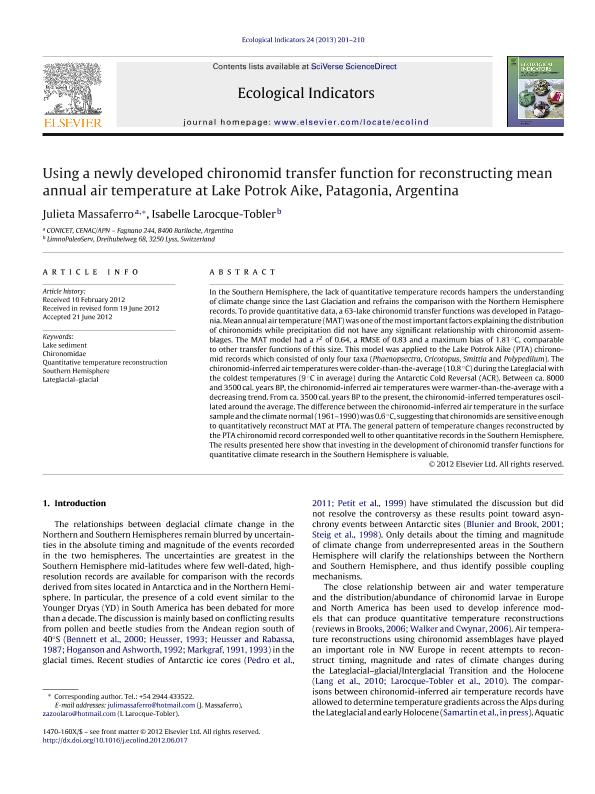Mostrar el registro sencillo del ítem
dc.contributor.author
Massaferro, Julieta

dc.contributor.author
Larocque Tobler, Isabelle
dc.date.available
2017-06-06T18:46:49Z
dc.date.issued
2013-01
dc.identifier.citation
Massaferro, Julieta; Larocque Tobler, Isabelle; Using a newly developed chironomid transfer function for reconstructing mean annual air temperature at Lake Potrok Aike, Patagonia, Argentina; Elsevier; Ecological Indicators; 24; 1-2013; 201-210
dc.identifier.issn
1470-160X
dc.identifier.uri
http://hdl.handle.net/11336/17594
dc.description.abstract
In the Southern Hemisphere, the lack of quantitative temperature records hampers the understanding of climate change since the Last Glaciation and refrains the comparison with the Northern Hemisphere records. To provide quantitative data, a 63-lake chironomid transfer functions was developed in Patagonia. Mean annual air temperature (MAT) was one ofthe mostimportantfactors explaining the distribution of chironomids while precipitation did not have any significant relationship with chironomid assemblages. The MAT model had a r2 of 0.64, a RMSE of 0.83 and a maximum bias of 1.81 ◦C, comparable to other transfer functions of this size. This model was applied to the Lake Potrok Aike (PTA) chironomid records which consisted of only four taxa (Phaenopsectra, Cricotopus, Smittia and Polypedilum). The chironomid-inferred air temperatures were colder-than-the-average (10.8 ◦C) during the Lateglacial with the coldest temperatures (9 ◦C in average) during the Antarctic Cold Reversal (ACR). Between ca. 8000 and 3500 cal. years BP, the chironomid-inferred air temperatures were warmer-than-the-average with a decreasing trend. From ca. 3500 cal. years BP to the present, the chironomid-inferred temperatures oscillated around the average. The difference between the chironomid-inferred air temperature in the surface sample and the climate normal(1961–1990) was 0.6 ◦C, suggesting that chironomids are sensitive enough to quantitatively reconstruct MAT at PTA. The general pattern of temperature changes reconstructed by the PTA chironomid record corresponded well to other quantitative records in the Southern Hemisphere. The results presented here show that investing in the development of chironomid transfer functions for quantitative climate research in the Southern Hemisphere is valuable.
dc.format
application/pdf
dc.language.iso
eng
dc.publisher
Elsevier

dc.rights
info:eu-repo/semantics/openAccess
dc.rights.uri
https://creativecommons.org/licenses/by-nc-nd/2.5/ar/
dc.subject
Fossil Chironomids
dc.subject
Transfer Functions
dc.subject
Southern Patagonia
dc.subject
Paleoclimate
dc.subject.classification
Otras Ciencias de la Tierra y relacionadas con el Medio Ambiente

dc.subject.classification
Ciencias de la Tierra y relacionadas con el Medio Ambiente

dc.subject.classification
CIENCIAS NATURALES Y EXACTAS

dc.title
Using a newly developed chironomid transfer function for reconstructing mean annual air temperature at Lake Potrok Aike, Patagonia, Argentina
dc.type
info:eu-repo/semantics/article
dc.type
info:ar-repo/semantics/artículo
dc.type
info:eu-repo/semantics/publishedVersion
dc.date.updated
2015-10-15T20:00:52Z
dc.journal.volume
24
dc.journal.pagination
201-210
dc.journal.pais
Países Bajos

dc.journal.ciudad
Amsterdam
dc.description.fil
Fil: Massaferro, Julieta. Administracion de Parques Nacionales; Argentina. Consejo Nacional de Investigaciones Científicas y Técnicas; Argentina
dc.description.fil
Fil: Larocque Tobler, Isabelle. Limnology and Paleolimnology Services; Suiza
dc.journal.title
Ecological Indicators

dc.relation.alternativeid
info:eu-repo/semantics/altIdentifier/doi/http://dx.doi.org/10.1016/j.ecolind.2012.06.017
dc.relation.alternativeid
info:eu-repo/semantics/altIdentifier/url/http://www.sciencedirect.com/science/article/pii/S1470160X12002488
Archivos asociados
